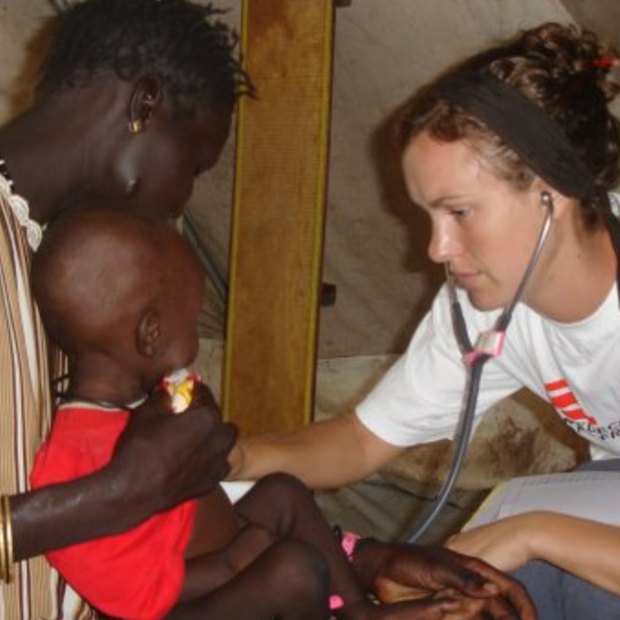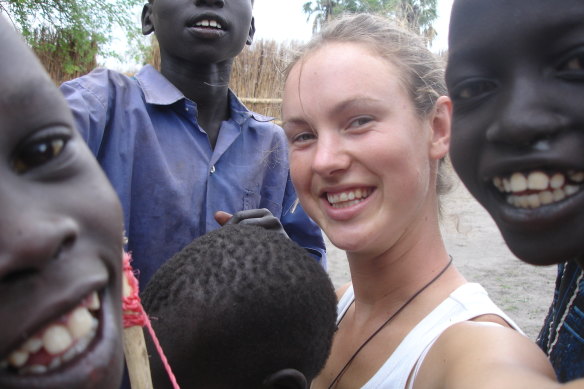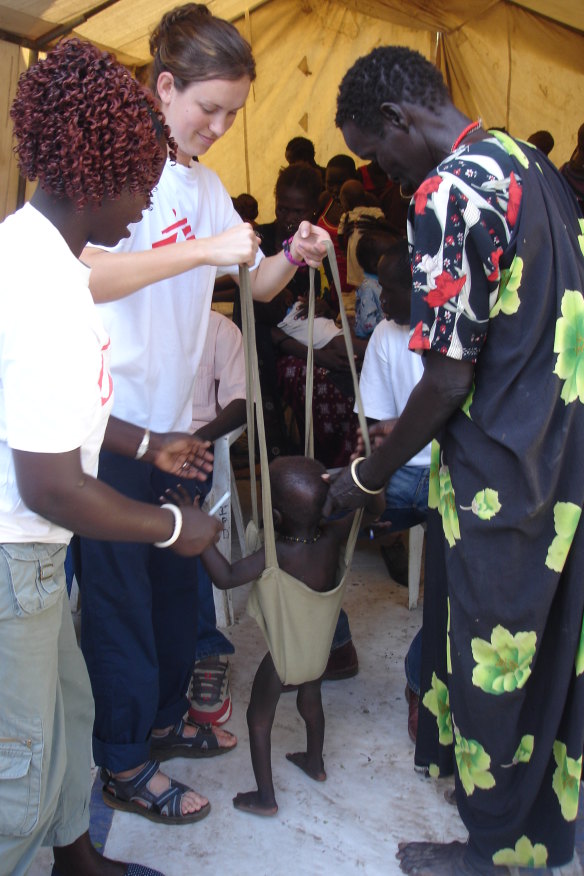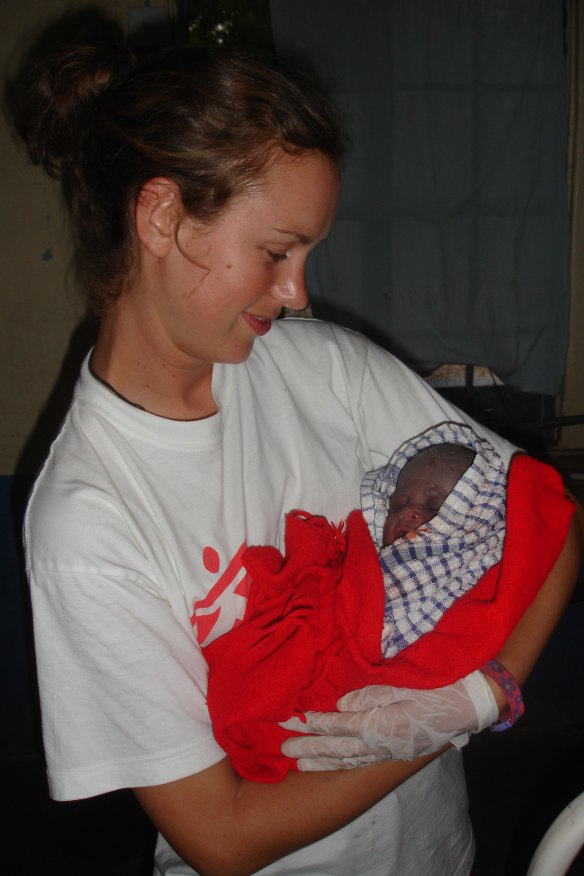This was published 3 years ago
‘Oh, my god! What’s that?’: My life as a midwife in South Sudan
A midwife swapped her comfortable life in England for the stark landscape of central Africa, where life-or-death choices were daily occurrences. Here, she recalls the dramatic day a teenager’s labour drew on skills she never thought she’d need.
By Anna Kent

Anna Kent examining a child in 2007 at the Therapeutic Feeding Centre in Leer, in what is now known as South Sudan.Credit: Courtesy of Anna Kent
As a young girl growing up in a comfortable home in a small Shropshire village, Anna Kent’s yearning to become an aid worker was ignited in the ’80s, when she was shocked by TV news footage of starving children in Ethiopia. Their skinny arms and wide eyes jolted her into the realisation that such suffering existed in the world – and she became determined to help. In April 2007, at the age of 26, with a nursing master’s degree and a diploma in tropical nursing under her belt, she flew to what is now known as South Sudan to begin her first assignment with Médecins Sans Frontières (MSF) – helping to run dramatically under-resourced healthcare units in the small towns of Tam and Leer.
With all inpatient beds full, Leer Hospital is bursting at the seams and many patients lie on mattresses on the ground. Working alongside us – Valerie, a 30-year-old Canadian nurse, and me – is Sunduk, an extremely competent local doctor who trained in the north of Sudan before joining MSF. Worryingly, I learn there’s no expat midwife here.
My heart sinks as more and more patients are carried across the central courtyard. Camilla, the Italian surgeon – all waving arms and curly brown hair – is shouting at everyone in earshot. She’s extremely skilled, with more than 20 years of war surgery to her credit, but I’m intimidated by her. While she deals with ridiculous caseloads in theatre, Valerie and I must act as her gatekeepers and decide who’s admitted and who must go home.
Turning people away is horrible. In the UK, working as an ED nurse at Queen’s Medical Centre, a massive teaching hospital in Nottingham said to have one of the busiest EDs in Europe, I never had to make these kinds of life-or-death choices and I know I’ll never get used to it. For instance, I must watch one teenage mother, discharged after childbirth, put a four-day-old baby in a reed basket on top of her head. Fragile, brave, she turns and smiles at me before her 16-kilometre walk home alone across a landscape strewn with landmines.
In this place, where everything is so chaotic and we have to make awful choices, I know I will go crazy if I fully respond, so bit by bit, I start to block out the things I can’t control, and focus only on the things I can.

Kent was 26 when she flew to central Africa to work for Médecins Sans Frontières.Credit: Courtesy of Anna Kent
One day, something so extraordinary happens it will stay with me for the rest of my life. I’m in the operating theatre inside Leer Hospital, checking the blood pressure of a recently amputated patient, and Valerie is in the ward next door. Camilla’s at the sink, washing her hands with her usual ferocity, getting ready for the next patient, when …
“Anna! Valerie! Quick!” a frantic voice comes through the window. It’s Michael, a Sudanese nurse. We race after him through the lines of patients, along the verandah and into the small, dark maternity ward now crowded with a group of tall women all wearing brilliantly coloured material tied over one shoulder. They cluster with an air of concern around a young Nuer woman, who I guess to be about 16 years old. Her name is Grace. With her long, thin neck and large, scared eyes, she looks like a skinny kid, but she has the most enormous pregnant belly I’ve ever seen – especially rare in South Sudan, where gestational bumps are usually small. This girl’s bursting belly is so enormous she can barely move.
The three of us heave Grace through a small doorway into a delivery room before the women shout at Michael to leave. Almost immediately, the contractions come with such force over Grace’s body that her toes curl and fists clench. Valerie and I look at each other with fear and bemusement – so many limbs are moving inside her extraordinary belly it looks like a bag of snakes. Michael bobs up again outside the delivery room and starts to translate in a low mutter through a rusted window covered with a frayed cotton sheet.
I’ve learnt that this awful hitting is sometimes traditional here. As labour is so dangerous, birth partners want women to use all their energy for pushing, not shouting.
Grandma, aunties and friends are shifting and murmuring. They can feel electricity in the air. When Valerie, after a preliminary feel of the girl’s abdomen, says “Twins!“, a charge of excitement shoots through the room. Amniotic fluid dribbles down Grace’s legs as she tries not to groan with her next contraction.
Valerie and I exchange sideways glances, trying to look super cool and competent so that the women relax, but neither of us has done this before. We know from our notebooks that, even in the UK, a twin delivery can quickly become an emergency if, say, the first baby is lying sideways, or a limb is delivered before a head. Often, in fully resourced hospitals, mothers of twins choose a planned caesarean section.
We ask Michael to call Camilla, but he murmurs through the window that she can’t come – she’s scrubbed and halfway through an emergency operation. Valerie takes what sounds like a yogic exhalation. My skin prickles. It’s us, then.
We know enough to recognise our first job is to figure out if a vaginal birth is possible – but that’s not easy without an ultrasound scan, or a trained maternity team, and with two babies packed into such a small space. Grace’s face is wet with sweat now, eyes rolling, contractions coming fast and hard. Then, crack! A female relative gives her leg a hard smack.
“Stop!” I say, before I can hold my tongue, and the women stare at me, muttering to each other in Nuer. I’ve learnt that this awful hitting is sometimes traditional here. As labour is so dangerous, birth partners want women to use all their energy for pushing, not shouting. It’s a valid fear in a country where more young women die in childbirth than complete high school.
I’m in the dry-mouthed, swooning terror of midwifery on the wing. Focusing back to the birth, there’s no safe way to slow down this labour – the babies are coming and we must do our best. “Two birthing kits!” Valerie yells through the fly-screen as we pull on our gloves. Michael runs to the man who sterilises surgical equipment in an autoclave above a wood fire behind the hospital.
One aunty, who’s stopped smacking, stays as a caretaker, the others leave – there’s no room in here for all of us. I put in an IV line. That’s fine, I do that well, I’m used to it. Valerie gets out emergency drugs and antibiotics in case the waters have been gone for some time. Okay. Calm down.
Grace, who’s so far been quiet, lets out a deep grunt. Putting the Pinard stethoscope on her abdomen, I’m hoping to hear the first baby’s heart rate. One, two, three, or is that my own heartbeat ringing in my ear? And then Thank god! I can hear one baby’s heart rate; it sounds like an adult beat, only faster and fainter.
I’m straining so hard to hear for a second baby on a different section of abdomen, but it’s difficult. Grace’s body is twisting in labour and picking up on two different heartbeats for two different babies is like trying to tune into two competing, but ghostly, radio stations. Valerie says, “We need to do a vaginal exam to assess cervical dilation.”
Too late! With another stifled groan, Grace bears down, her vagina widens spontaneously and it’s happening so fast and I can already see a small head pushing forward determinedly at the perineum. It’s scary, but also amazing. This very small head, with no hair, is covered in a thick, creamy vernix, a sign of prematurity. “Aghhhhhhh!” Grace lets her cry out for the first time.
Valerie stands like a wicketkeeper between the girl’s legs, holding a clean cotton sheet from a delivery kit handed to us through the window. When the baby arrives quickly with the next push, Valerie catches it like a pro. “It’s a boy!” she yells, her smile one of pure delight. This baby is tiny, bluish, but crying. I’m still frightened, but so focused and alive, nothing exists but this moment.
I’m trying to delay clamping and cutting the cord, when one of the aunties dashes in, scoops up the tiny boy, puts him to her mouth, sucks out any sputum from his nose and mouth, spitting it on to the floor beside me. Honestly, I want to gag; it’s a local practice I won’t ever get used to, but in a world with rare medical assistance, it works as a basic resuscitation manoeuvre. We clamp and cut the cord.
Now swaddled by the aunty, the boy is quickly whisked away next door into the arms of a delighted older lady I assume is Grandma. “No! No! Skin-to-skin,” I shout through the window to Michael, so he can instruct them to put the tiny baby directly onto their skin. There are no incubators in this hospital for prem babies – I don’t think there are any other quality neo-natal facilities in the whole of South Sudan. Only the new supply of knitted baby hats my mum and her friends donated, and the life-saving warmth of being next to skin. “Kangaroo care” it’s often called, and it’s life-saving here.
But Nuer women have their own customs, and they bundle up the baby. They don’t have to listen to us, and I can’t talk directly to them. “Tell them he needs to feed in the next hour,” Valerie shouts over her shoulder to Michael. This tiny boy is at risk of both heat loss and low blood sugar unless he has breast milk promptly. It’s his only chance; formula milk in South Sudan, where the water is often dirty, is simply too dangerous.

Kent weighs a young child ahead of admission. Children are regularly admitted for malnutrition.Credit: Courtesy of Anna Kent.
Back on the table, the labour continues with force, but thankfully very little bleeding. “Oh, my god!” Valerie’s staring between the mother’s legs, her eyes wide. “What’s that?”
Two bulging purple sacks start to deliver. My first thought is that it’s a deformity since, only the previous week, a baby was born with gastroschisis (its bowel outside the body) and sadly died. A baby that most likely would’ve survived with surgery in the UK or Australia. Grace is still pushing and, with the next grunt, a tiny scrotum appears, then buttocks. The legs are wrapped around the baby’s ears – a frank breech position. With the next final, expulsive push, another tiny boy shoots into my waiting, trembling hands. He’s blue and startled – rub him vigorously with a clean sheet to stimulate him – an imaginary instructor is next to me, giving me resuscitation instructions. Within a minute, the baby starts to cough and snort, his legs still in a frog-like position due to the way he’d been lying inside.
When this second baby cries, tears brim in my wide, shocked eyes. What incredible joy to deliver two premature boys, weak and weighing only one kilogram each, but alive in spite of all the odds against them. Moments later, when he’s taken through to be wrapped and cooed over by the women next door, I hear shrieks of happiness and loud, shrill, ululating calls, and I want to yell, too. But instead, I watch Valerie’s smile die. She’s giving Grace’s abdomen a final feel, before injecting the oxytocin and ergometrine that helps the placenta deliver.
“Something’s wrong,” she says. “Get Camilla.” Her face is white. I feel confused, sick. Why? Grace’s tummy is half the size it was before; her belly teek [a decorative belt of beads] is loose. And then I follow her stare and put my hand over Grace’s uterus. Something is moving in there. Something alive. “There’s another one!” I yell. “Get a delivery kit!”
My hands are shaking. I have enough textbook knowledge to know that in the UK, triplets are almost never delivered vaginally, the risks of one child dying, or of a limb obstructing the delivery, are simply too high. The women next door pick up on our change of tone; they’re screaming now, too.
Calm down, Anna! Concentrate, take a breath. Grace’s child-like hands are bunched into fists so tight that her nails are digging into her palms, her eyes are squished. She needs you to think.
A few seconds later, she bears down again with such effort that her bowels open. And just as I’m wiping away the faeces, a third head appears, and a baby girl is born with one final push into both Valerie and my hands.
She is quickly dried with a golden sarong an aunty unties from her shoulder – we have no new sterile towel. She’s unbelievably small and so fragile. Later we’ll weigh her and find she’s only 900 grams, less than a bag of sugar. But now she’s screaming loudly as if to announce her own arrival. We cut the cord, and when she’s raced next door, the aunties and Grandma explode into an all-singing, all-ululating dance of celebration.

Kent with baby Moses in 2007 – her first time assisting at a birth.Credit: Courtesy of Anna Kent
“Oh … my … goodness!” Valerie and I gawp at each other in disbelief. “Any more in there?” we laugh, as I give the injection of ergometrine and Valerie feels Grace’s tummy.
Camilla runs into the room, pushes past us and puts her hands onto Grace’s belly. “Give another injection of ergometrine,” she barks. “Start the IV. Get the misoprostol ready.”
The placenta delivers, but has broken into pieces. Immediately Camilla puts a gloved hand deep into the girl’s vagina. When she pulls out other broken pieces, they look like lumps of liver. Blood starts to pour from the girl like a crimson river. A postpartum haemorrhage like this could easily escalate and kill Grace. I’m frantically giving more drugs, but they’re not working.
“No tone in her uterus, there’s tissue left inside,” Camilla says bluntly, her face wet with sweat. Grace collapses before our eyes on the birth table and I have no more drugs I can use.
“I’ll prepare for surgery. Do this.” Camilla gives me a sterile glove, bunches up her right hand like a boxer and shows me how to push my right hand deep into Grace’s vagina, while my left hand simultaneously pushes hard on her abdomen from the outside. I squeeze the uterus between my two hands, a manoeuvre called bimanual compression, only to be used in very dire circumstances. It’s something all UK midwives are trained in, but thankfully few ever have to use. “Until I say stop!” Camilla commands.
Grace is carried to theatre on a stretcher made of sticks. Thin legs sticking out, me shuffling alongside, my fist in her vagina, arm painful from cramp, but desperate not to let go. Valerie throws a bright purple and green sarong over her for dignity.
Blood starts to pour from the girl like a crimson river. A postpartum haemorrhage like this could easily escalate and kill Grace.
Grace, who I’ve known for just under an hour, is at the brink of death. Her face is waxy, her eyes unfocused. Michael is squeezing IV fluids into her; he’s shouting to family members saying they’ll all need to be tested for blood donation. Person-to-person blood transfusions are our only hope out here.
Door frames slamming, people shouting, deep breath, Grace’s unconscious arm flops off the stretcher. When Camilla quickly injects her with ketamine, the girl’s eyes roll back in her head. Ketamine, used in the UK to tranquillise horses and illegally as a club drug, may sound like an odd choice of anaesthetic, but it’s our only option here. Enough of a dose will knock her unconscious for surgery, but she’ll still be able to breathe for herself. Put simply, the complex ventilation equipment that’s standard elsewhere just isn’t available here.
I’m not needed in theatre. Camilla has her excellent national staff team, one of whom is armed with a swat, squashing the flies that happily followed us in. Camilla’s bundling her wild hair under a sun-bleached green theatre hat, she’s inserting the knife, telling me to leave.

Kent with Angelina, a Sudanese MSF worker in Tam, South Sudan. The tent in the background was part of Kent’s living quarters.Credit: Courtesy of Anna Kent
Back in the maternity ward, Grace’s sister, who has her own baby, is expressing drops of her breast milk into three babies’ waiting mouths. This potentially runs the risk of a blood-borne virus being transmitted through breastmilk, though rates of infection are low here and we’ll later screen her to find that she’s thankfully negative. But in the circumstances, it’s probably the best way of keeping these babies alive – the usual rock and a hard place of choices.
When I walk into the room, an aunty I’d shouted at earlier for smacking smiles and points at the girl baby. “Nyakawai,” she says, lifting the baby up like a chalice. Like gold. She can’t stop smiling. Nor can Grandma, who has a big toothless grin and who touches me tenderly on the top of my head, saying sweet-sounding words I can’t understand. “Nyakawai means ‘foreign woman’,” Michael says.
They’ve named the baby girl after Valerie and me, and at last proper tears pour down my face, tears of relief and disbelief that these babies are so bright and alert. Tears of fear, too – if Grace dies, these babies will probably die, too. In southern Sudan in 2007, some 1500 women died in childbirth per 100,000 live births, a figure that compares starkly to maternity care back home in the UK, where, in the same year, there were 10 deaths per 100,000 births. That is the clear difference made by access to maternity care and absence of war.
An hour later, a drowsy Grace is stretchered back to the maternity ward with a large plaster covering the lower section of her abdomen. She looks like a sleeping child, but at 16 she’s just had a hysterectomy, because without this operation she would almost certainly have bled to death. She will never bear children again.
Camilla explains that the triplet placentas had grown vessels through the wall of the uterus and actually into Grace’s own blood supply and organs (a condition known in medical textbooks as placenta percreta). This abnormal placenta would usually have been detected on a routine ultrasound scan, though a hysterectomy might still have been the eventual outcome.
As I write this, I yearn to know what Grace’s life was like as a woman no longer able to bear children.
Grace stays with us for the next 10 days. After a blood transfusion, I see her first tentative smile as she successfully rotates the woolly-hatted triplets between herself and her sister for breastfeeds. Then I watch her walk home with a basket of babies balanced on her head. She’s wearing the same purple and green sarong that we’d flung over her in a moment of extremity, now washed and dried, and tied smartly over her shoulder.
As I write this, I yearn to know what Grace’s life was like as a woman no longer able to bear children. Baby Nyakawai would be 15 now, if she survived, which is unlikely, but I force myself to believe that she did.
This is an edited extract from Anna Kent’s Frontline Midwife: My Story of Survival and Keeping Others Safe (Bloomsbury, $30), out May 31.
To read more from Good Weekend magazine, visit our page at The Sydney Morning Herald, The Age and Brisbane Times.
The best of Good Weekend delivered to your inbox every Saturday morning. Sign up here.